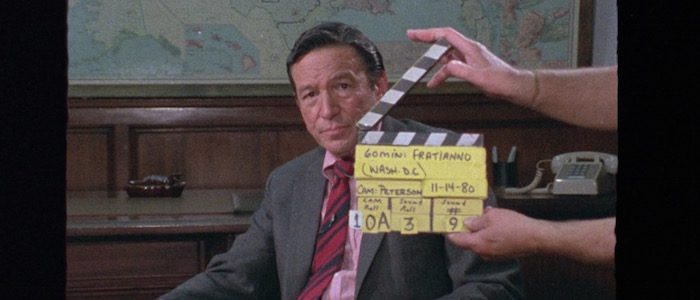
One of the emerging trends in the films at this year’s True/False documentary film festival in Columbia, Missouri has been curated footage. Several of the films at this year’s festival, like Apollo 11, Amazing Grace and now director Avi Belkin’s film Mike Wallace is Here, are made up entirely of archival content, either presented in a linear way, or edited together in such a way that it creates a complete picture all on its own.
In the case of Mike Wallace is Here, Belkin has assembled clips comprising the majority of the 60 Minutes journalist’s career, as well as interview clips where Wallace himself is the subject. The goal is twofold: to create a portrait of a notoriously tough journalist who mostly evaded the tough questions asked of him, and to consider the impact that his brand of journalism had on the way we report the news. Basically, based on what records we have of Wallace, and the way he conducted his work, what can we glean about the man?
It’s a pretty even-handed, nuanced look. There are equal amounts of vanity, integrity and guilt. We see Wallace go hard on people who don’t seem to deserve it, but also doggedly pursue subjects who do. When he’s interviewed, he decries a question about the number of times he’s been married as cheap journalism, then we watch him ask the same of Larry King just a few seconds later. In the film’s opening, he calls out then-Fox News commentator Bill O’Reilly for his on-air bullying, only to have O’Reilly tell him that Wallace is one of the major inspirations behind his career.
In exploring the few personal elements Wallace shares of himself, the results feel uncomfortably selfish. Wallace started off in radio and TV as an ad announcer and occasional actor, eventually making the move to interviewing with Night Beat, his network interview show. The shift to journalism was accompanied by a feeling that he had to prove himself to the news establishment, eventually turning Wallace into a workaholic, and quickly causing the dissolution of his first marriage.
Discussing his son Peter’s 1962 death with his 60 Minutes colleague Morley Safer, Wallace is strikingly unemotional, and his reaction self-centered. “Nothing like that had ever happened to me before,” he tells Safer, as if his son’s death impacted only himself, and was an event to be dealt with, rather than something that required processing in community. The film’s most revealing information is on the depression Wallace experienced later in his career. However, due to the dated content, and the progression of how we understand depression and anxiety even over the last few years, it’s a discussion that skews heavily toward questioning why Wallace’s many accomplishments suddenly weren’t enough for him.
Mike Wallace is Here also details, through years of 60 Minutes clips, the role Wallace and others of a particular period in broadcasting played in turning the news cycle into a ratings contest, eventually introducing hidden camera investigative pieces that presaged Nightline and To Catch a Predator. Wallace decries the existence of shows like Hard Copy, but seems unwilling to recognize that the show, and others like it, took many cues in its formatting and subject matter from the success of 60 Minutes.
Perhaps the most interesting aspect of the film is how, in trying to dig into its subject, it reveals how much of Wallace’s feelings about work, success and life in general appear to have been absorbed from his interviews with others. An early interview with The Twilight Zone creator Rod Serling seems to echo Wallace’s own dogged work ethic, as does a discussion with Larry King. A talk with Bette Davis touches on ideas about personal relationships and professional accomplishments that also seem familiar when Wallace talks about himself.
The cultural impact of all those attitudes, however, appear not to bother Wallace too much, even as we see the short and long-term consequences of his reporting all through the film. His interview with Iran’s Ayatollah Khomeini arguably leads to the assassination of Anwar Sadat. His techniques and involvement in the rise of TV news magazines is echoed in the words of Bill O’Reilly when O’Reilly claims to have “won the game of broadcast journalism.”
All of this is done without extra editorializing on Belkin’s part. The strength of the format the director’s chosen for Mike Wallace is Here is that he can work toward shaping a thesis that’s backed up entirely by documentation. Often, documentaries on public figures follow a prescribed trajectory – they’re a hagiography, or a highlight reel. Belkin’s documentary is something else entirely, attempting to compile a portrait of a public figure by taking an honest look at the work they produced. It’s an approach similar to the way Wallace describes his own legacy: tough but fair. It’s neither a smear campaign nor a hymn of praise. It’s a genuine attempt to understand.
/Film Rating: 8 out of 10
The post ‘Mike Wallace is Here’ Review: A Complicated Portrait of a Public Figure appeared first on /Film.
from /Film https://ift.tt/2IR0EzB


No comments:
Post a Comment